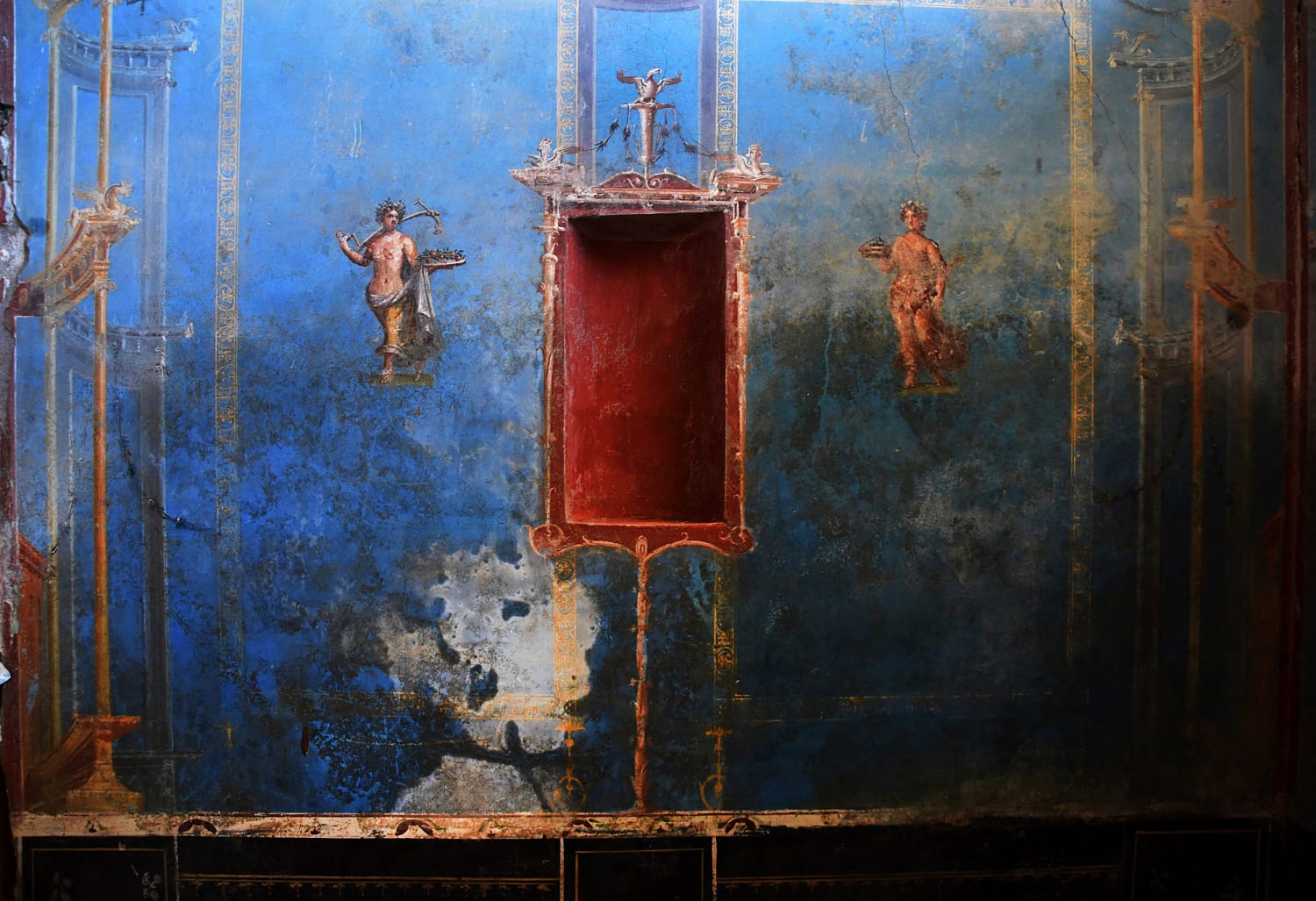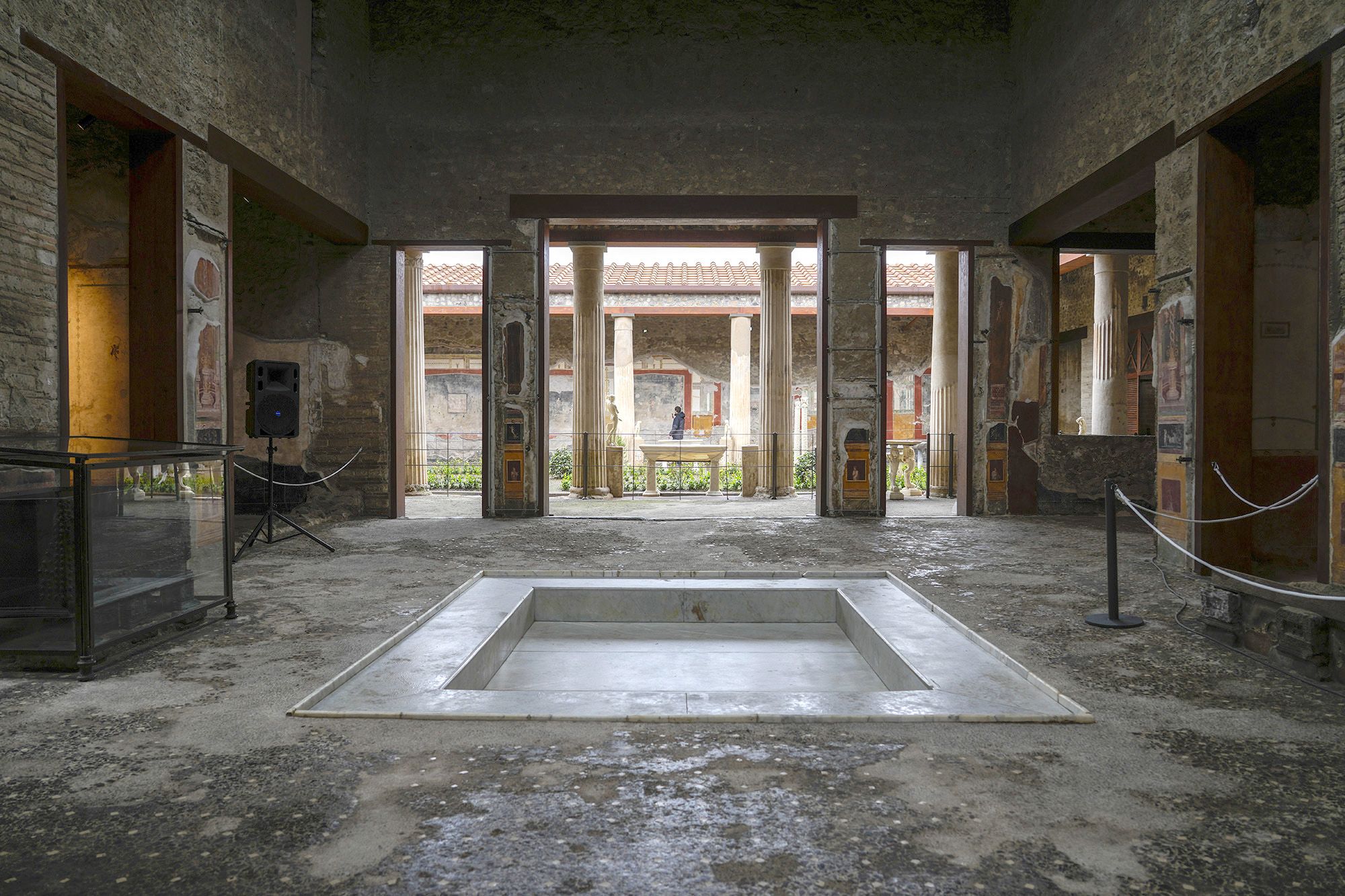
Pompeii, a name synonymous with a moment frozen in time, continues to yield incredible secrets, two thousand years after Mount Vesuvius dramatically reshaped its landscape. Imagine stepping back into that world, not just seeing the ruins, but glimpsing the vibrant colors, feeling the opulence, and even sensing the human drama that unfolded in the final hours. Recent excavations are pulling back the volcanic ash layer by layer, revealing an ancient city that is, as Italy’s Minister of Culture Gennaro Sangiuliano described, “a treasure chest that is still partly unexplored.” The work currently underway in the Regio IX area is particularly exciting, peeling back almost an entire city block and presenting us with a panorama of ancient Roman life, from the grandest luxury to the starkest reality.
One of the most enchanting discoveries emerging from this significant excavation is a room painted in a vivid, sky-blue hue. This color is a truly rare sight in Pompeian frescoes, typically reserved for spaces of profound significance. Found within the Insula 10 area of Regio IX, this exquisite 8-square-meter space is interpreted as a sacrarium, a place dedicated to ancient ritual activities and the safekeeping of sacred objects. It’s a window into the spiritual life of the house’s inhabitants, cloaked in a color that would have been precious and meaningful.
The walls of this special blue room, also known as Room 32, are a feast for the eyes, adorned with frescoes in the intricate Fourth Style. This style, popular in the decades leading up to the eruption in AD 79, is known for its complex narratives and painted architectural elements that create a sense of depth and richness. On this rare blue canvas, female figures come to life, representing the four seasons, allegories of agriculture, and even shepherding. These figures, often adorned with crowns of flowers or depicted with flowing garments, lend the room a mystical, almost ethereal atmosphere, hinting at the nature of the rituals performed here.

The archaeologists found compelling evidence supporting the sacrarium interpretation right within the room itself. Among the discoveries were fifteen transport amphorae, large terracotta vessels often used for wine or olive oil, resting against a wall. Additionally, a set of bronze objects, including two jugs and two lamps, were unearthed. These items, along with three decorative boxes embedded in the walls, likely held devotional statues or other sacred objects, further cementing the room’s role as a private sanctuary.
Intriguingly, piles of building materials were also found scattered throughout the house, including a heap of oyster shells in the blue room. This detail paints a picture of a residence undergoing renovation at the time the volcano erupted. Painters would grind these oyster shells into a fine powder to mix with plaster and mortar, creating a luminous finish for the walls, perhaps even contributing to the iridescent shimmer planned for this very blue space. It underscores how suddenly disaster struck, interrupting not just daily life, but also the plans and improvements for the future.
The blue sacrarium is just one piece of a much larger puzzle being meticulously assembled in Regio IX. The excavation has unearthed a vast and grand residence, possibly belonging to a wealthy individual, potentially the influential politician Aulus Rustius Verus. This domus is revealing room after room, each offering unique insights into the elite lifestyle of ancient Pompeii. It truly emphasizes the scale of the private homes owned by the city’s most affluent residents.
Among the most spectacular finds in this residence is a sumptuous private bathhouse complex. Dr. Gabriel Zuchtriegel, the director of the Archaeological Park of Pompeii, has called this a “once-in-a-century” discovery, potentially the largest private bath complex ever found in Pompeii. This spa-like suite highlights the incredible luxury enjoyed by the city’s wealthiest inhabitants. It contained everything needed for the full Roman bathing experience, including hot, warm, and cold rooms, exquisite artwork, and a massive plunge pool.

Imagine the experience of using this private retreat. Guests would enter a changing room featuring vibrant red walls, a beautifully patterned mosaic floor inlaid with marble from across the Roman Empire, and practical stone benches. From there, they would move to the caldarium, the hot room, stepping into a bath and enjoying the sauna-like warmth generated by an ingenious system of suspended floors and wall cavities that allowed hot air to circulate freely. It shows a remarkable understanding of heating and air circulation for the time.
The journey through the bathhouse would continue to the tepidarium, the brightly-painted warm room. This was likely a space for treatments, where oil would be rubbed onto the skin before being scraped off with a strigil, a curved instrument. The final destination was the frigidarium, the cold room, the largest and perhaps most visually stunning space of the complex. Surrounded by red columns and frescoes depicting athletes, visitors could cool off in a huge plunge pool. Dr. Zuchtriegel muses about the scene: “In the hot summers, you could sit with your feet in the water, chatting with your friends, maybe enjoying a cup of wine.” This massive pool was so large it could accommodate twenty to thirty people, underscoring the scale of private entertainment possible in such a home.
This grand residence also included a huge banqueting room, discovered last year, with dramatic jet-black walls adorned with breathtaking artwork of classical scenes, including themes from the Trojan War. There was also a smaller, more intimate room, painted in pale blue, that residents would use for prayer to the gods. These different spaces within a single home illustrate the multifaceted life of a wealthy Roman family – spaces for public display, private leisure, personal devotion, and everyday living, all under one roof.
Yet, the excavations in Regio IX offer more than just glimpses of luxury and art; they starkly reveal the profound social stratification of ancient Pompeii. Just behind the sophisticated hot room of the bathhouse lies the boiler room. Here, a furnace sat beneath a lead boiler, heating water for the baths. Pipework and taps, looking remarkably modern, managed the water flow from the street. The conditions in this cramped, hot room would have been unbearable, highlighting the stark contrast between the bathers’ comfort and the toil of the slaves forced to keep the system running. Dr. Sophie Hay, an archaeologist at Pompeii, powerfully states, “The most powerful thing from these excavations is that stark contrast between the lives of the slaves and the very, very rich. And here we see it.” She adds, “The difference between the sumptuous life of the bathhouse, compared to the furnace room, where the slaves would be feeding the fire toiling all day. ‘A wall is all that could divide you between two different worlds.'”
This sharp divide is further emphasized by another recent discovery in a villa just outside Pompeii, at Civita Giuliana. Here, archaeologists unearthed the humble quarters of the servants. This space was starkly utilitarian, completely devoid of the decorative frescoes found in the luxurious areas. It contained simple items like a bed, work tools, a basket, rope, and wooden planks, preserved by the volcanic ash. The contrast with the intricately painted sacrarium or the grand bathhouse could not be more striking, vividly illustrating the two vastly different worlds that coexisted side-by-side within Roman society.
Another extraordinary find in Regio IX, in a spacious banqueting room of the newly named “Casa del Thiasus” (House of Thiasus), is an almost life-size frieze known as a “megalography.” This rare artwork, dating back to the first century BC, is attributed to the Second Style of Pompeian painting and was already around a hundred years old when Vesuvius erupted. It provides a unique glimpse into the world of mystery cults. The frieze, running around three sides of the room, depicts the vibrant and enigmatic procession of Dionysus, the god of wine.

The megalography is packed with fascinating details. Bacchantes, also known as maenads, are shown as dancers but also as fierce hunters, carrying slaughtered kid goats or wielding swords and animal entrails. Young satyrs with pointed ears play the double flute, while another performs a dramatic wine sacrifice. At the heart of the scene is a woman with an old Silenus, holding a torch, signifying her initiation into the mysteries of Dionysus – a cult promising a new, blissful life. It’s a powerful depiction of a hidden aspect of Roman religious life.
One of the most interesting artistic choices in the frieze is that the figures are depicted on pedestals, giving them the appearance of statues. However, their dynamic movements, complexions, and clothing simultaneously make them seem incredibly lifelike. This play between illusion and reality adds another layer to the artwork’s complexity. This newly discovered frieze is only the second example of a megalography with similar rituals found in Pompeii, the other being the famous Mystery frieze in the Villa of the Mysteries.
The House of Thiasus frieze adds the theme of hunting to the Dionysiac initiation rites, a detail not as prominent in the Villa of the Mysteries. Above the main frieze with bacchantes and satyrs, a second, smaller frieze depicts living and dead animals, including a fawn, a wild boar that has just been gutted, cockerels, various birds, fish, and seafood. It adds another layer to the symbolic world being portrayed. Minister of Culture Alessandro Giuli rightly declared, “In 100 years, today will be seen as historic, because the discovery we are showing is historic.” He highlights that this megalograph is an “exceptional historical document” and, combined with the Villa of the Mysteries fresco, makes Pompeii an “extraordinary testimony to an aspect of life in classical Mediterranean life that is largely unknown.”
Dr. Gabriel Zuchtriegel explains the deeper meaning behind the Dionysiac scenes. He notes that the hunt depicted by the bacchantes is a metaphor for an unrestrained, ecstatic life aimed at achieving “great, wondrous things,” referencing Euripides’ play ‘Bacchae’. For the ancients, the bacchante or maenad represented the wild, untameable side of women, the one who abandons societal norms to dance and hunt freely. This stands in contrast to the ‘nice’ woman who emulates Venus, focusing on love and marriage. These frescoes, while decorating spaces for banquets, also reflect a profound religious meaning and perhaps even hint at a religious crisis affecting the ancient world, while simultaneously echoing archaic rituals dating back millennia to the worship of Dionysus/Zagreus.

The ongoing excavation in Regio IX is a massive undertaking, covering about 3,200 square meters, almost an entire insula or city block. This extensive project began in February 2023 and is now in its final phase, focusing on ensuring safety and preparing for future permanent access for visitors. The project aims to reconnect this area with the existing urban fabric of the site. Beyond the grand domus, the excavation has unearthed other structures, including atrium houses that were transformed into workshops, such as a fullonica or laundry, and a bakery complete with an oven, millstones, and rooms for processing food.
The total scale of the discoveries in this single area is staggering: over 50 new rooms have been brought to light across a surface area exceeding 1500 square meters. While many incredible spaces like the bathhouse, blue sacrarium, and Dionysiac banqueting room have been revealed, areas such as the entrance, the atrium complex, and a large part of the peristyle or porticoed garden still await full exploration. It emphasizes that Pompeii truly is a treasure chest with more to give.
Related posts:
Pompeii: Spectacular new discoveries unearthed include private spa
Archaeologists uncover mysterious ‘blue room’ in Pompeii
POMPEII, DISCOVERY OF A ROOM WITH FRESCOES DEPICTING THE INITIATION INTO THE MYSTERIES AND THE DIONYSIAC PROCESSION




